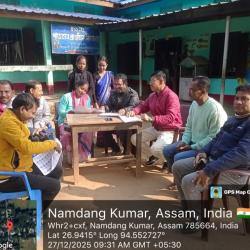Keeping in view the concept of traditional theatre workshops, the second year students of the prestigious National School of Drama, last year, underwent a 45-day workshop in Asom to practice and carry out research work on the traditional dramatic forms of the State. The research subject of their workshop was Ankiya Naat Bhaona and their mentor was the ever-reinventing theatre worker, Gunakor Deva Goswami. The participants of the workshop were also graced with the presence of doyen of Sattriya tradition, Guru Nrityacharya Padmashree Jatin Goswami. Besides equipping the participants with a plethora of new skills and appreciable knowledge of Bhaona, the workshop also evolved a critically acclaimed play, Usha Parinaya, which was staged recently at Rabindra Bhavan.
NSD students are known for their penchant for perfection. Gunakar, meanwhile, is known for his calibre and his approach towards theatrical production, which includes meticulous research, use of hitherto unused traditional choreography, and perfection. When both of them combine, the result is bound to be scintillating. And so is the case with Usha Parinaya.
The story of Usha Parinaya is basically taken from the Bhagavat Purana and has been evolved by compiling various sub-stories and incidents with elements of fantasy taken from Ananta Kandali’s Kumara Haran. The play is characterised with the usage of specific elements of Ankiya Naat and is also influenced by the music and body movements of Ojapali. The play revolves around the mythological love story of Anniruddha, the grandson of Lord Krishna, and Usha, the daughter of Baana Asura — a powerful and mighty Asura King who was blessed as the owner of a thousand soldiers. One night, Usha dreams of being in an amorous embrace with a valiant and handsome young prince. Filled with undiluted passion and love, Usha, along with her friend Chitralekha, sets out to find the mysterious prince to finally discover that he is none other than Annirudha, the grandson of Lord Krishna. Chitralekha kidnaps Annirudha who gets married to Usha, much to the anger of Bana Asura. The Asura Kind locks horns with Lord Shiva, resulting in a great war which threatened to destroy the entire universe. However, peace ultimately prevails and Usha is finally married off to Aniruddha who takes her to Dwarka.
Though the play has a lot of highlights, the character of Sutradhar was very well enacted. For those who do not know, the character of Sutradhar is a very important part of Ankiya Bhaona. The Sutradhar describes the entire drama from its beginning to the end. Besides introducing the play, describing the characters and the movement of the play, the Sutradhar keeps reminding the audience about the required devotion towards God. And keeping with the essence of innovation which is the hallmark of Usha Parinaya, the Sutradhar was also highly inventive in introducing the characters and in describing the movement of the play.
The brilliant handling of the love and war scenes, the rhythmic yet vigorous body movements of the characters, the varied compositions of music — all this manage to lend an ephemeral quality to the entire play. As director Gunakar Deva Goswami says, “More emphasis has been given to the representation of characters than on the dialogues. However, the dialogues have a unique sweetness in itself. Rhythmic physical language is considered as the main feature of the play, the structural design of which is based on this very feature. But Usha Parinaya is not a play in the form of a Bhaona. I can say that it is an independent play, which has some new elements of Bhaona and which incorporates a new language of practice and training. The outcome of voice rendering, physical and mental training which the students went through can be gauged from the end result of the play.”
Bhaona is mainly a subject of xewa (devotion). It is mainly performed as a prayer, which is the main barrier in presenting this art in front of an audience. Keeping this aspect in mind, it is imperative that utmost care is taken while presenting these types of plays. It is true that Bhaona can be presented as a movable art form by retaining all its characteristics, but for that it is necessary to have highly skilled performing artistes in dance, music and acting. And Gunakar and his team has been highly successful in this regard.
Besides the highly intense scenes of love and war, there are a few comical scenes in the play as well. The comical elements in the character of Kuji burhi, Usha’s caretaker, cannot be ignored. Shahjahan Hussain has also given a highly powerful performance as ‘Narad’. With Usha Parinaya, Gunakar Dev Goswami has elevated regional theatre to a new level, besides laying the foundation for contemporary theatrical production to draw more from indigenous art forms.
------------------------------
About the Director:
Gunakar Dev Goswami was born on February 3, 1970 in Asom. Born in a cultural family, Gunakar tried to incorporate the traditional Art forms in his theatrical productions, and experimented to invent an alternative Asomiya theatre, using the rich Asomiya indigenous performing Arts and culture as the springboard. His attempts gave birth to the organization, Purbaranaga. Gunakar is the first Asomiya theatre worker who is trying to present Ankiya Naat and Bhaona on the theatrical stage with modern techniques of design. Having participated in a number of national and international theatre festivals, he has been bestowed with a host of awards and fellowships.
About the Guru:
Guru Nrityacharya Padmashree Jatin Goswami was born at the Adhar Satra, Dergaon in 1933. Having devoted his entire life for the propagation and holistic development of Sattriya traditions, the Nrityacharya is a living legend. His venture, ‘Nrityanjali 2000’ was a milestone in the history of experimentation and innovation in Sattriya dance. In recognition of his immense contributions, he was titled as ‘Nrityacharya’ by the Sankari Sangeet Vidyapith. The Government of India conferred the prestigious Padmashree title on him in 2008.
NSD students are known for their penchant for perfection. Gunakar, meanwhile, is known for his calibre and his approach towards theatrical production, which includes meticulous research, use of hitherto unused traditional choreography, and perfection. When both of them combine, the result is bound to be scintillating. And so is the case with Usha Parinaya.
The story of Usha Parinaya is basically taken from the Bhagavat Purana and has been evolved by compiling various sub-stories and incidents with elements of fantasy taken from Ananta Kandali’s Kumara Haran. The play is characterised with the usage of specific elements of Ankiya Naat and is also influenced by the music and body movements of Ojapali. The play revolves around the mythological love story of Anniruddha, the grandson of Lord Krishna, and Usha, the daughter of Baana Asura — a powerful and mighty Asura King who was blessed as the owner of a thousand soldiers. One night, Usha dreams of being in an amorous embrace with a valiant and handsome young prince. Filled with undiluted passion and love, Usha, along with her friend Chitralekha, sets out to find the mysterious prince to finally discover that he is none other than Annirudha, the grandson of Lord Krishna. Chitralekha kidnaps Annirudha who gets married to Usha, much to the anger of Bana Asura. The Asura Kind locks horns with Lord Shiva, resulting in a great war which threatened to destroy the entire universe. However, peace ultimately prevails and Usha is finally married off to Aniruddha who takes her to Dwarka.
Though the play has a lot of highlights, the character of Sutradhar was very well enacted. For those who do not know, the character of Sutradhar is a very important part of Ankiya Bhaona. The Sutradhar describes the entire drama from its beginning to the end. Besides introducing the play, describing the characters and the movement of the play, the Sutradhar keeps reminding the audience about the required devotion towards God. And keeping with the essence of innovation which is the hallmark of Usha Parinaya, the Sutradhar was also highly inventive in introducing the characters and in describing the movement of the play.
The brilliant handling of the love and war scenes, the rhythmic yet vigorous body movements of the characters, the varied compositions of music — all this manage to lend an ephemeral quality to the entire play. As director Gunakar Deva Goswami says, “More emphasis has been given to the representation of characters than on the dialogues. However, the dialogues have a unique sweetness in itself. Rhythmic physical language is considered as the main feature of the play, the structural design of which is based on this very feature. But Usha Parinaya is not a play in the form of a Bhaona. I can say that it is an independent play, which has some new elements of Bhaona and which incorporates a new language of practice and training. The outcome of voice rendering, physical and mental training which the students went through can be gauged from the end result of the play.”
Bhaona is mainly a subject of xewa (devotion). It is mainly performed as a prayer, which is the main barrier in presenting this art in front of an audience. Keeping this aspect in mind, it is imperative that utmost care is taken while presenting these types of plays. It is true that Bhaona can be presented as a movable art form by retaining all its characteristics, but for that it is necessary to have highly skilled performing artistes in dance, music and acting. And Gunakar and his team has been highly successful in this regard.
Besides the highly intense scenes of love and war, there are a few comical scenes in the play as well. The comical elements in the character of Kuji burhi, Usha’s caretaker, cannot be ignored. Shahjahan Hussain has also given a highly powerful performance as ‘Narad’. With Usha Parinaya, Gunakar Dev Goswami has elevated regional theatre to a new level, besides laying the foundation for contemporary theatrical production to draw more from indigenous art forms.
------------------------------
About the Director:
Gunakar Dev Goswami was born on February 3, 1970 in Asom. Born in a cultural family, Gunakar tried to incorporate the traditional Art forms in his theatrical productions, and experimented to invent an alternative Asomiya theatre, using the rich Asomiya indigenous performing Arts and culture as the springboard. His attempts gave birth to the organization, Purbaranaga. Gunakar is the first Asomiya theatre worker who is trying to present Ankiya Naat and Bhaona on the theatrical stage with modern techniques of design. Having participated in a number of national and international theatre festivals, he has been bestowed with a host of awards and fellowships.
About the Guru:
Guru Nrityacharya Padmashree Jatin Goswami was born at the Adhar Satra, Dergaon in 1933. Having devoted his entire life for the propagation and holistic development of Sattriya traditions, the Nrityacharya is a living legend. His venture, ‘Nrityanjali 2000’ was a milestone in the history of experimentation and innovation in Sattriya dance. In recognition of his immense contributions, he was titled as ‘Nrityacharya’ by the Sankari Sangeet Vidyapith. The Government of India conferred the prestigious Padmashree title on him in 2008.
- 58079 reads










Add new comment